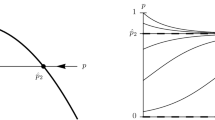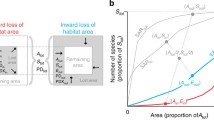Abstract
HABITAT destruction is the major cause of species extinctions1–3. Dominant species often are considered to be free of this threat because they are abundant in the undisturbed fragments that remain after destruction. Here we describe a model that explains multispecies coexistence in patchy habitats4 and which predicts that their abundance may be fleeting. Even moderate habitat destruction is predicted to cause time-delayed but deterministic extinction of the dominant competitor in remnant patches. Further species are predicted to become extinct, in order from the best to the poorest competitors, as habitat destruction increases. More-over, the more fragmented a habitat already is, the greater is the number of extinctions caused by added destruction. Because such extinctions occur generations after fragmentation, they represent a debt—a future ecological cost of current habitat destruction.
Similar content being viewed by others
References
Ehrlich, P. & Ehrlich, A. Extinction (Ballantine Books, New York, 1981).
Wilson, E. O. Biodiversity (National Academy, Washington DC, 1988).
Simberloff, D. Zh. Obshch. Biol. 45, 767–778 (1984).
Tilman, D. Ecology 75, 2–16 (1994).
Levins, R. & Culver, D. Proc. natn. Acad. Sci. U.S.A. 68, 1246–1248 (1971).
Horn, H. S. & MacArthur, R. H. Ecology 53, 749–752 (1972).
Cohen, D. & Levin, S. A. Theo. Pop. Bio. 39, 63–99 (1991).
Hastings, A. Theo. Pop. Bio. 18, 363–373 (1980).
Hanski, I. Ecology 64, 493–500 (1983).
Levin, S. A. & Paine, R. T. Proc. natn. Acad. Sci. U.S.A. 71, 2744–2747 (1974).
Gaines, S. & Roughgarden, J. Proc. natn. Acad. Sci. U.S.A. 82, 3707–3711 (1985).
Harrison, S., Murphy, D. D. & Ehrlich, P. R. Am. Nat. 132, 360–382 (1988).
Hanski, I. in Living in a Patchy Environment (eds Shorrocks, B. & Swingland, I. R.) 127–145 (Oxford Univ. Press, UK, 1990).
Shorrocks, B. Biol. J. Linn. Soc. 43, 211–220 (1991).
Sale, P. F. The Ecology of Fishes on Coral Reefs (Academic, New York, 1991).
Doherty, P. & Fowler, T. Science 263, 935–939 (1994).
Werner, P. A. & Platt, W. J. Am. Nat. 110, 959–971 (1976).
Shmida, A. & Ellner, S. Vegetatio 58, 29–55 (1984).
Grubb, P. J. in Community Ecology (eds Diamond, J. & Case, T.) 207–226 (Harper & Row, New York, 1986).
Nee, S. & May, R. M. J. Anim. Ecol. 61, 37–40 (1992).
May, R. M. in Ecology and Evolution of Communities (eds Cody, M. L. & Diamond, J. M.) 81–120 (Harvard Univ. Press, Cambridge, MA, 1975).
Diamond, J. M. Proc. natn. Acad. Sci. U.S.A. 69, 3199–3203 (1972).
Terborgh, J. BioScience 24, 715–722 (1974).
Case, T. J., Bolger, D. T. & Richman, A. D. in Conservat. Biology (eds Fielder, P. L. & Jain, S. K.) 91–125 (Chapman & Hall, New York, 1992).
Lovejoy, T. E. et al. in Extinctions (ed. Nitecki, M. H.) 295–325 (Univ. of Chicago Press, Chicago, 1984).
Bucher, E. H. Curr. Ornithol. 9, 1–36 (1992).
Chapin, F. S. A. Rev. Ecol. System. 11, 233–260 (1980).
Pastor, J., Aber, J. D., McClaugherty, C. A. & Melillo, J. M. Am. Mid. Nat. 108, 266–277 (1982).
Tilman, D. & Downing, J. A. Nature 367, 363–365 (1994).
Naeem, S., Thompson, L., Lawler, S., Lawton, J. H. & Woodfin, R. Nature 368, 734–737 (1994).
Author information
Authors and Affiliations
Rights and permissions
About this article
Cite this article
Tilman, D., May, R., Lehman, C. et al. Habitat destruction and the extinction debt. Nature 371, 65–66 (1994). https://doi.org/10.1038/371065a0
Received:
Accepted:
Issue Date:
DOI: https://doi.org/10.1038/371065a0
- Springer Nature Limited
This article is cited by
-
Consistent stoichiometric long-term relationships between nutrients and chlorophyll-a across shallow lakes
Nature Communications (2024)
-
Toward a Multi-stressor Theory for Coral Reefs in a Changing World
Ecosystems (2024)
-
Unveiling the impacts of forest loss on taxonomic and phylogenetic beta diversity of juvenile and adult tropical trees
Biodiversity and Conservation (2024)
-
The impact of habitat loss and population fragmentation on genomic erosion
Conservation Genetics (2024)
-
Significant decline in habitat specialists in semi-dry grasslands over four decades
Biodiversity and Conservation (2024)





